References - Mockingjay's are a hybrid between the fictional Jabberjays & actual Mockingbirds, so starting there:
Not bad, on the book cover art the wings are a little longer/thinner than an actual mockingbird, so they have a few more feathers to them, but they seem to share the same most of the same feather shapes as found here:
However, we'll be using the MOVIE interpretation, which is best found in the title sequence & movie posters:
The wings are not fully open, but already this version is sharper and longer than the book art (probably to look more dramatic, like a bird of prey or a crow/raven), which we'll have to take into account when sizing the feathers.
Luckily, I found a fully-open wing version of the movie one, found here in the form of a metal Christmas ornament:

I'll be using the left wing for my feather sizing, since it's straighter and less overextended than the right. It's easy to imagine where the wing bones are for the wrist & shoulder, our two most important spots to match up on our human subject. Speaking of which, here she is now!
Standing with your arm parallel to the ground holding a yardstick is about the best pose you can get for matching up your reference wing to your own arm. I've marked the shoulder & wrist in orange here, and will be doing the same thing for the wing reference, so that initially it's just a matter of rotating & resizing the wing to match.
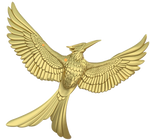

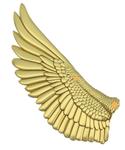

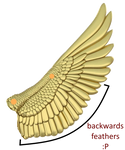
Using Paint.NET since it's got simpler mechanics that are easier to explain, though the following could be done just as easily in Inkscape or Photoshop, etc:

Put the wing on it's own layer with a lower opacity, makes it easier to match up.
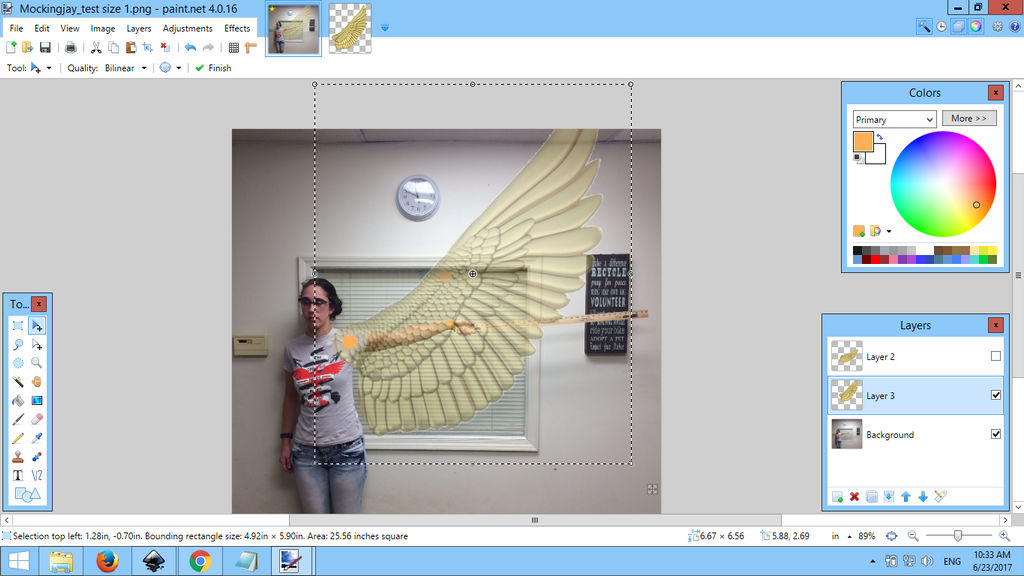
Shoulder point locked - once this is in place, drag the (x) n the center of the selected wing to the orange shoulder point, & rotate it until the wing's wrist point is in line with the human reference.
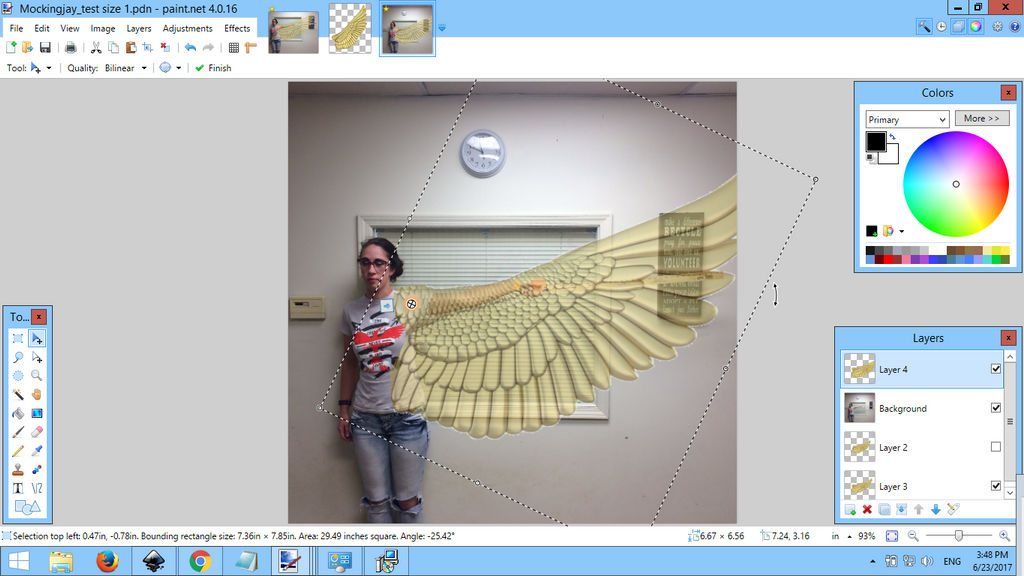
Now hold down 'Shift' and click/drag the upper right corner of the box to resize the reference wing until the 2nd orange point matches up with the wrist marker. Holding down 'Shift' locks the wing's aspect ratio, and prevents you from accidentally making it too thick or skinny.
Exhibit A:
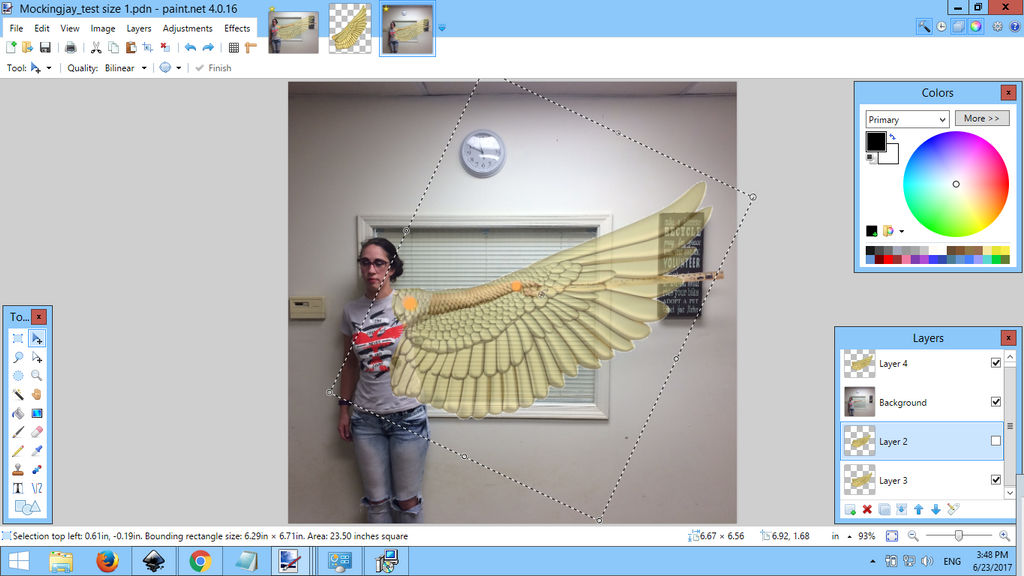
Not bad! It's a wing alright~ Still, take a moment to really look at it. Imagine how the wings would look if you made the feathers this long. Does it feel right? If not, fiddle with it until it does, for instance:
Exhibit B:
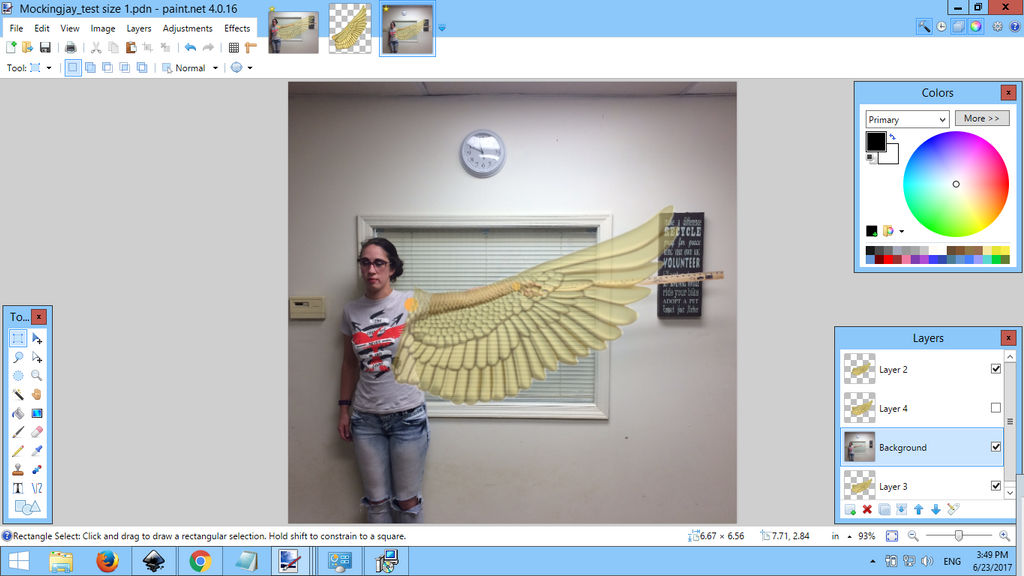
The first one feels very big and showy, but might be a bit much for a first-time wing-maker, heavier & harder to navigate in small spaces (also, in Exhibit A the longest feather will definitely drag on the ground if their arms are slack/not held up a certain amount, where with Exhibit B there's a higher chance it'll be possible to give your arms a break & not mess up your feather tips...)
Exhibit A & B overlaid for comparison (a few inches makes a big difference in how the final result feels, I think):
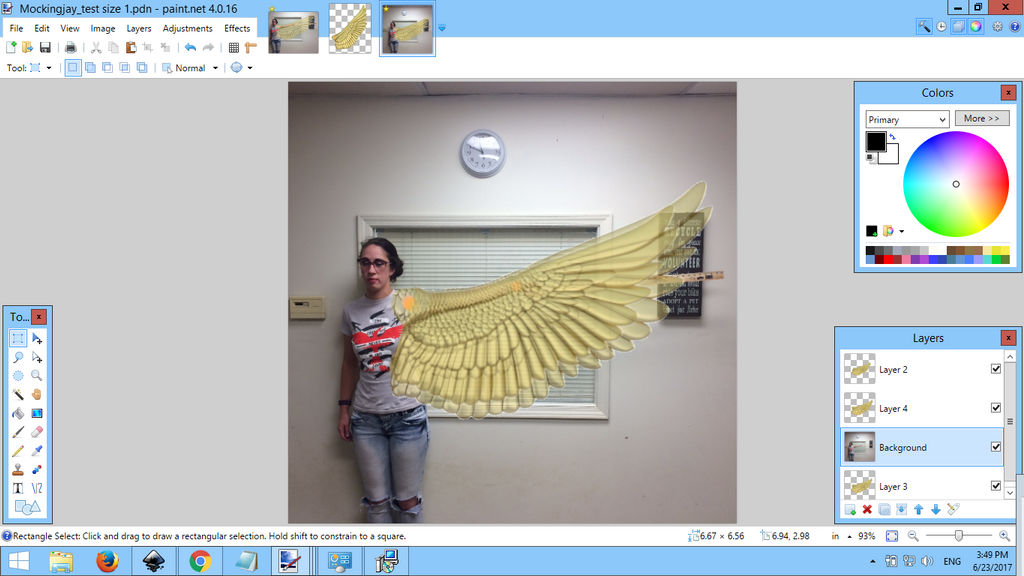
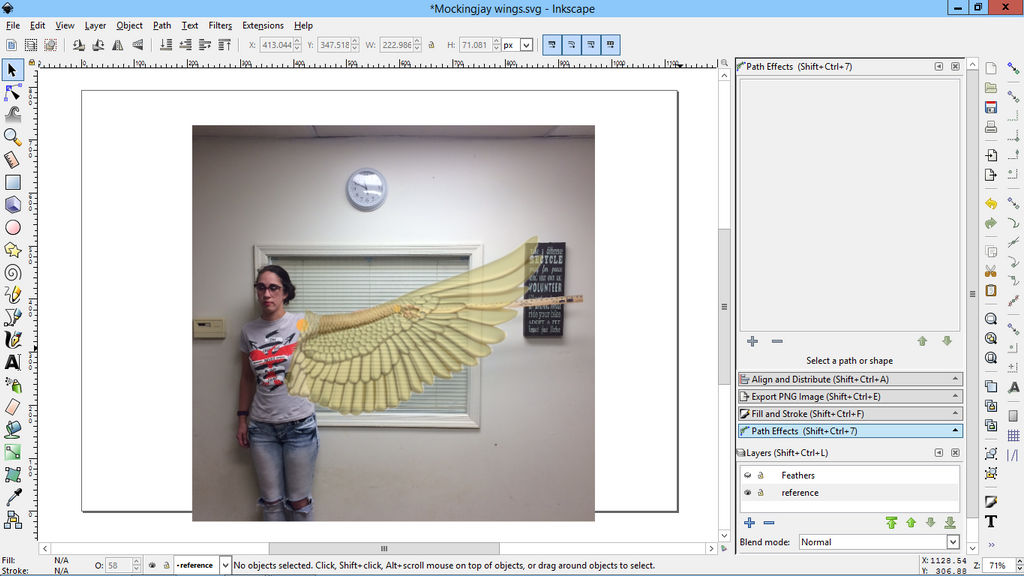
So here we are in Inkscape. I've put the reference photo with wing included on one layer, and created another above it for the feathers. Before we start tracing out feathers & laying down shafts, we'll need to decide on a few reference points.
First - while I lined up the arm and wing-reference pretty well, it's not quite perfect, so I'll make a quick shape that'll act as a stand-in for a more accurate hand/wrist position holding the wing. This way it shows the orange pivot point where it will actually be, hanging off the glove below the wrist, with the hand holding the leading feather.
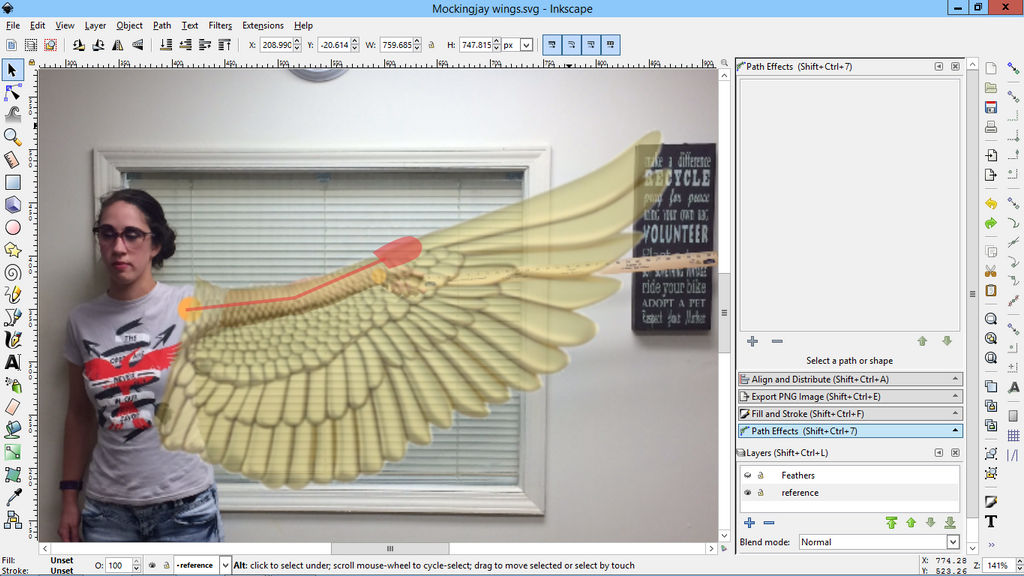
Next, I'll make a circle to represent the actual pivot point, and use that to "snap" my lines to when I'm making them, as well as a thin, yellow rectangle to represent the elastic that holds the secondary feathers & will be fully extended when the wing is open, going from the back of the shoulder to next to the pivot point.

And now the tricky part - deciding which feathers to keep & which to ignore/combine. If we refer to the closest real-life counterpart, the Mockingbird, the wings should have around 10 primary feathers and 10 secondary feathers. But according to this reference...

...it has 9 primary feathers and 13-15 secondary ones. Well, the book-reference of the Mockingjay has the same little primary feather the Mockingbird does, so I've added a line back in to represent that one, and we have the expected 10 primaries. As for the secondaries, having so many certainly adds to the feathery look (and it's not too many more than expected), so we'll roll with it for now. We can always change our minds later if we want to leave out a few, widening the remaining secondary feathers and spacing them farther apart to hide the gaps.
Well, the book-reference of the Mockingjay has the same little primary feather the Mockingbird does, so I've added a line back in to represent that one, and we have the expected 10 primaries. As for the secondaries, having so many certainly adds to the feathery look (and it's not too many more than expected), so we'll roll with it for now. We can always change our minds later if we want to leave out a few, widening the remaining secondary feathers and spacing them farther apart to hide the gaps.
I'll be making the primary feather shafts in red, and the secondary shafts in black. All the primary shafts snap on to that pivot-point circle, while the secondaries need to just overlap the yellow elastic-rectangle in a realistically spaced way. Some pointers:

Not bad, though the faults in this reference show even more here, and the feathers are oddly shaped in some places - let's use the Mockingbird feather reference and fix that!
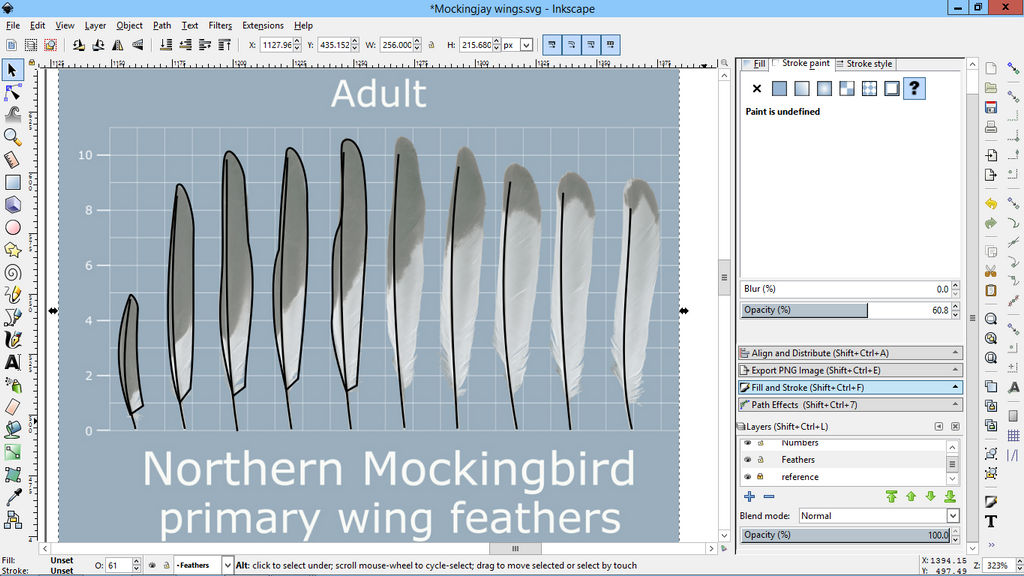
First, I made simple-shapes around each of the feathers from the Feather Atlas, then I dragged those over & resized them for the Mockingjay wing.
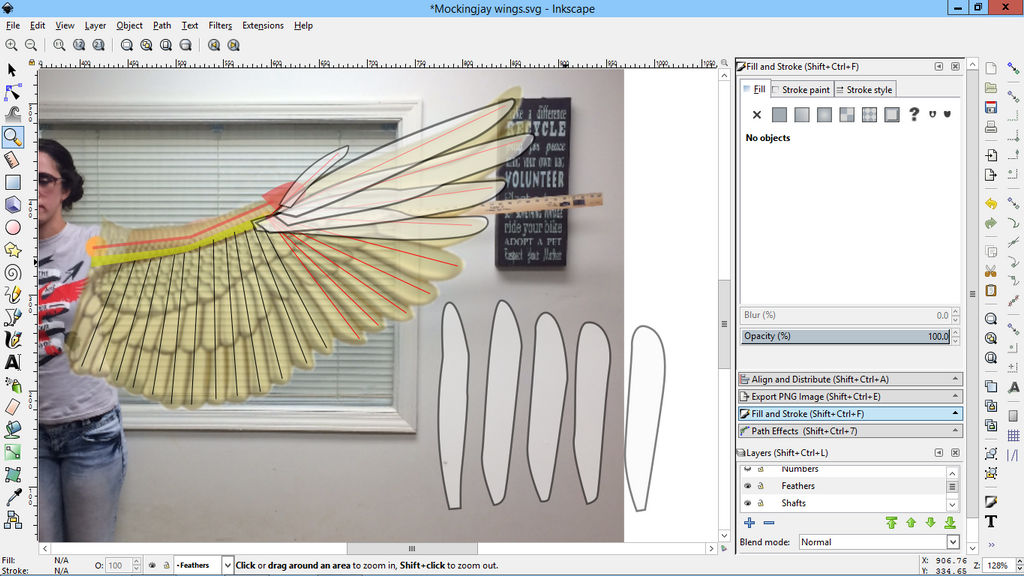
Then the Secondaries over the black guides:

Once they're all in place, I adjust the feather shapes and shafts as needed until I get the overall shape & wing silhouette that I like. I also shave away parts of the original feather shapes that no longer fit with the wing design, i.e. the extra bits that overlap past the pivot points, elastic, etc.
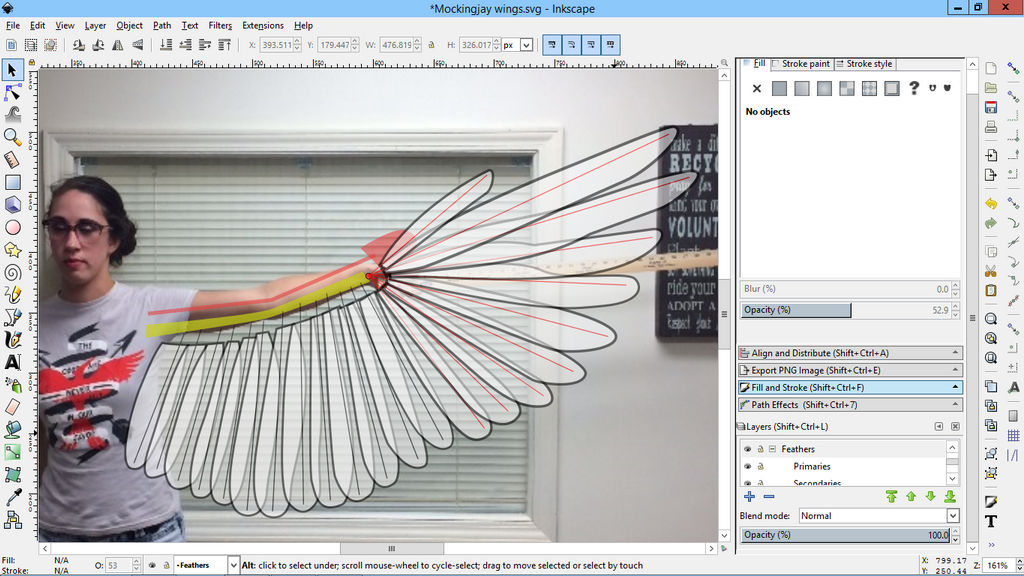
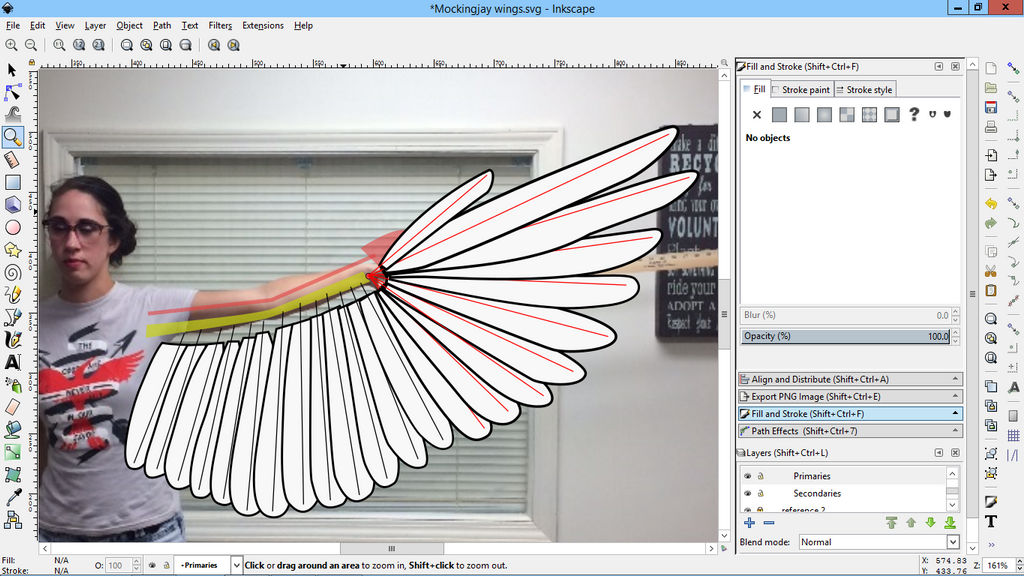
I like how it looks at this stage, and after copying what I have & flipping the order of the feathers I can get a sneak peek of how the back of the wing will look.

Looks alright, so time to figure out just how long these feather shafts actually are so we know how much wire to buy & straighten!
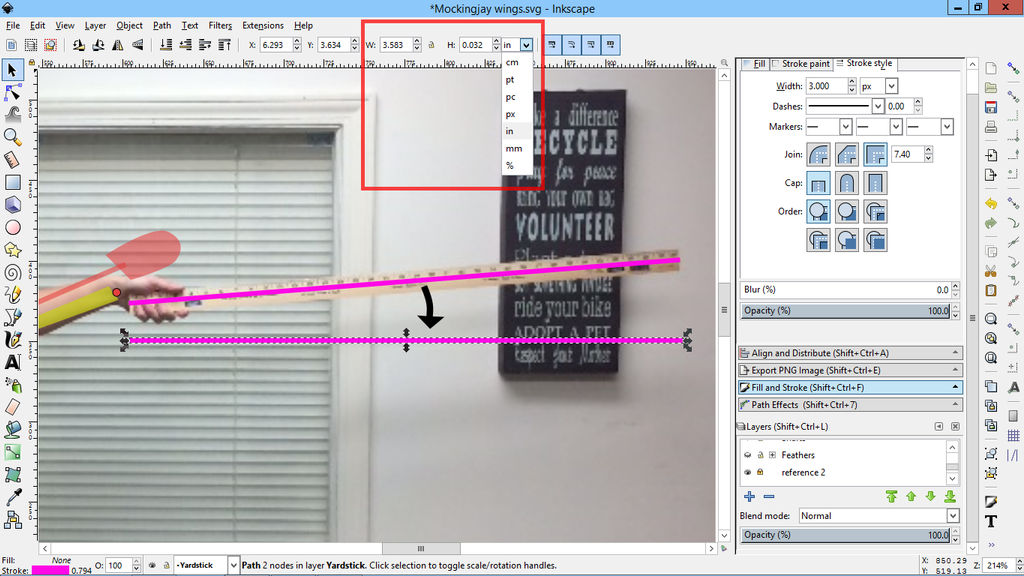
From here, since I plan on making a printable version, I change the measurements to "in"/inches, click & close the lock between the width/height measurements & change the width to 36 inches.
My base paper size here is A4, so easy to see the yardstick size in comparison (us Letter size, if you're in the US, whatever is most commonly used for printing). The original digital yardstick, by comparison, is only a little over 3 inches long, so now we have to scale it and all the feathers/shafts up to match the actual 36-inch yardstick.

Here's how you do it in Inkscape:

On the top bar, under "Object", click "Transform", which'll open up that tool. With your tiny digital yardstick selected, in the new "Transform" tool select the "Scale" tab. Choose "in" from the drop-down list of measurement types, and type in "36" to be the new width. Now, BEFORE you transform anything, go back to the drop-down list and change "in" to "%", and it'll tell you the same percentage needed to turn your tiny digital yardstick - as well as all your feathers & shafts - into their correct scale in inches. Nice, huh? Does all the tricky math for you!


Now it's a matter of making a copy of the shafts only, taking each one by one, laying them flat (rotate them until the line is horizontal it's dotted selection box and you'll be close enough), and writing down the width that shows up in inches in the top/center boxes (make sure the measurements are still in inches, sometimes this likes to revert back to pixels).

Once this is done, I rearrange the feathers so that none of them overlap and can be printed easily (each feather numbered, thinner strokes, etc) on as few pieces of paper as possible - in this instance I went with an 8 by 6 grid of Letter sized paper (24 pages in total).

After saving a PDF copy, I open the giant 51 " x 44" feather spread in Adobe Reader, which in version 9 and above has the handy "tiling" option that automatically cuts & prints each piece out on it's proper page, complete with trim & overlap markings, if you so desire, though I usually do without, assembling the entire poster-sized piece & filling in the missing edges/gaps myself with a black pen.

And for those who don't have access to Adobe Reader, I have a neat plugin that lets me save the tiled results to another PDF, which is available for download in the description, here:
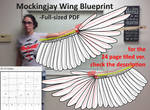
I hope you find these instructions helpful in your own wing designs. If you come up with anything new that you make and wish to share, shoot me a line, I always enjoy seeing what others can come up with~
And if you have any questions, comment below.
Later!

Programs used for this process: Paint.NET and Inkscape
Standing with your arm parallel to the ground holding a yardstick is about the best pose you can get for matching up your reference wing to your own arm. I've marked the shoulder & wrist in orange here, and will be doing the same thing for the wing reference, so that initially it's just a matter of rotating & resizing the wing to match.



*tries to ignore the backwards secondary feathers*
Using Paint.NET since it's got simpler mechanics that are easier to explain, though the following could be done just as easily in Inkscape or Photoshop, etc:

Put the wing on it's own layer with a lower opacity, makes it easier to match up.

Shoulder point locked - once this is in place, drag the (x) n the center of the selected wing to the orange shoulder point, & rotate it until the wing's wrist point is in line with the human reference.

Now hold down 'Shift' and click/drag the upper right corner of the box to resize the reference wing until the 2nd orange point matches up with the wrist marker. Holding down 'Shift' locks the wing's aspect ratio, and prevents you from accidentally making it too thick or skinny.
Exhibit A:

Not bad! It's a wing alright~ Still, take a moment to really look at it. Imagine how the wings would look if you made the feathers this long. Does it feel right? If not, fiddle with it until it does, for instance:
Exhibit B:

The first one feels very big and showy, but might be a bit much for a first-time wing-maker, heavier & harder to navigate in small spaces (also, in Exhibit A the longest feather will definitely drag on the ground if their arms are slack/not held up a certain amount, where with Exhibit B there's a higher chance it'll be possible to give your arms a break & not mess up your feather tips...)
Exhibit A & B overlaid for comparison (a few inches makes a big difference in how the final result feels, I think):

I recommend using Inkscape for the next part, since every line you make is an object that can be easily manipulated, changed, and measured within the program, but if you don't have the time or energy to download and learn the basics, this can be done in Paint.NET as well, just make sure that each line/feather is on it's own layer."What do you think Lalaithiel, A or B?"
"B please."
"Gotcha. Now then..."

So here we are in Inkscape. I've put the reference photo with wing included on one layer, and created another above it for the feathers. Before we start tracing out feathers & laying down shafts, we'll need to decide on a few reference points.
First - while I lined up the arm and wing-reference pretty well, it's not quite perfect, so I'll make a quick shape that'll act as a stand-in for a more accurate hand/wrist position holding the wing. This way it shows the orange pivot point where it will actually be, hanging off the glove below the wrist, with the hand holding the leading feather.

Next, I'll make a circle to represent the actual pivot point, and use that to "snap" my lines to when I'm making them, as well as a thin, yellow rectangle to represent the elastic that holds the secondary feathers & will be fully extended when the wing is open, going from the back of the shoulder to next to the pivot point.

And now the tricky part - deciding which feathers to keep & which to ignore/combine. If we refer to the closest real-life counterpart, the Mockingbird, the wings should have around 10 primary feathers and 10 secondary feathers. But according to this reference...

...it has 9 primary feathers and 13-15 secondary ones.
I'll be making the primary feather shafts in red, and the secondary shafts in black. All the primary shafts snap on to that pivot-point circle, while the secondaries need to just overlap the yellow elastic-rectangle in a realistically spaced way. Some pointers:
- Primary feather shafts tend to be near the top edge of the feather, which is called the "leading edge" and is important for flight, and for our purposes realism. However, feather shafts are rarely perfectly straight. It's to keep the feather-making process simpler & less time consuming that we use straight lines and wire to represent our shaft. It won't be perfect, just do your best when placing it in your design~
- The Secondary feathers that follow after the Primary ones tend to have similar shafts at first, but they slowly shift to being more in the middle of the feather the further you get from the Primary fan. Look closely at the feather references and you'll see what I mean.
- Make sure to extend the line very close, but not quite touching, the tip of your feather. Careful not to leave too much of a gap - any more than 1 - 1.5 inches, in my experience, is risky, though this depends heavily on your fabric type - as the tips of the feathers will be weaker than the rest of it, and may bend and flop around if they're too big.
- By the same token, don't put your wire too close to the edge of your fabric, any less than a centimeter and you risk it splitting open after some wear and tear has accumulated (though hot glue can be a quick fix for this).

Not bad, though the faults in this reference show even more here, and the feathers are oddly shaped in some places - let's use the Mockingbird feather reference and fix that!

First, I made simple-shapes around each of the feathers from the Feather Atlas, then I dragged those over & resized them for the Mockingjay wing.
- Note: Renamed the "Feathers" layer to "Shafts" and made a new "Feathers" layer, so that I could lock the shaft layer & avoid misclicks when positing the feather shapes.

Then the Secondaries over the black guides:

Once they're all in place, I adjust the feather shapes and shafts as needed until I get the overall shape & wing silhouette that I like. I also shave away parts of the original feather shapes that no longer fit with the wing design, i.e. the extra bits that overlap past the pivot points, elastic, etc.


I like how it looks at this stage, and after copying what I have & flipping the order of the feathers I can get a sneak peek of how the back of the wing will look.

Looks alright, so time to figure out just how long these feather shafts actually are so we know how much wire to buy & straighten!
- Make a rectangle or line the same length as the yardstick in the reference shot (if it's at an angle, rotate it afterwards to be as flat as possible, to make judging its measurement easier).
- Make a copy of this digital yardstick, and see how long it is currently, found in the "W: ____" info area near the top-middle of the Inkscape window when a shape is selected (W = width, by the way) which I've boxed in red in the picture below.

From here, since I plan on making a printable version, I change the measurements to "in"/inches, click & close the lock between the width/height measurements & change the width to 36 inches.
My base paper size here is A4, so easy to see the yardstick size in comparison (us Letter size, if you're in the US, whatever is most commonly used for printing). The original digital yardstick, by comparison, is only a little over 3 inches long, so now we have to scale it and all the feathers/shafts up to match the actual 36-inch yardstick.

Here's how you do it in Inkscape:

On the top bar, under "Object", click "Transform", which'll open up that tool. With your tiny digital yardstick selected, in the new "Transform" tool select the "Scale" tab. Choose "in" from the drop-down list of measurement types, and type in "36" to be the new width. Now, BEFORE you transform anything, go back to the drop-down list and change "in" to "%", and it'll tell you the same percentage needed to turn your tiny digital yardstick - as well as all your feathers & shafts - into their correct scale in inches. Nice, huh? Does all the tricky math for you!


Now it's a matter of making a copy of the shafts only, taking each one by one, laying them flat (rotate them until the line is horizontal it's dotted selection box and you'll be close enough), and writing down the width that shows up in inches in the top/center boxes (make sure the measurements are still in inches, sometimes this likes to revert back to pixels).

Once this is done, I rearrange the feathers so that none of them overlap and can be printed easily (each feather numbered, thinner strokes, etc) on as few pieces of paper as possible - in this instance I went with an 8 by 6 grid of Letter sized paper (24 pages in total).

After saving a PDF copy, I open the giant 51 " x 44" feather spread in Adobe Reader, which in version 9 and above has the handy "tiling" option that automatically cuts & prints each piece out on it's proper page, complete with trim & overlap markings, if you so desire, though I usually do without, assembling the entire poster-sized piece & filling in the missing edges/gaps myself with a black pen.

And for those who don't have access to Adobe Reader, I have a neat plugin that lets me save the tiled results to another PDF, which is available for download in the description, here:

I hope you find these instructions helpful in your own wing designs. If you come up with anything new that you make and wish to share, shoot me a line, I always enjoy seeing what others can come up with~
And if you have any questions, comment below.
Later!
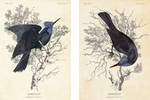
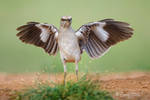
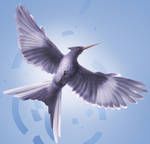
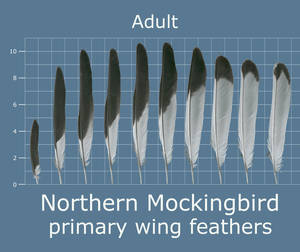


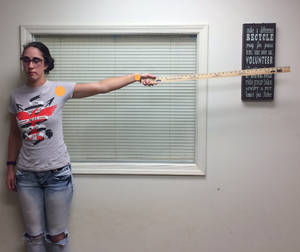
:origin()/pre00/2757/th/pre/f/2010/217/5/f/wip_costume_wings_by_sunnybrook1.png)